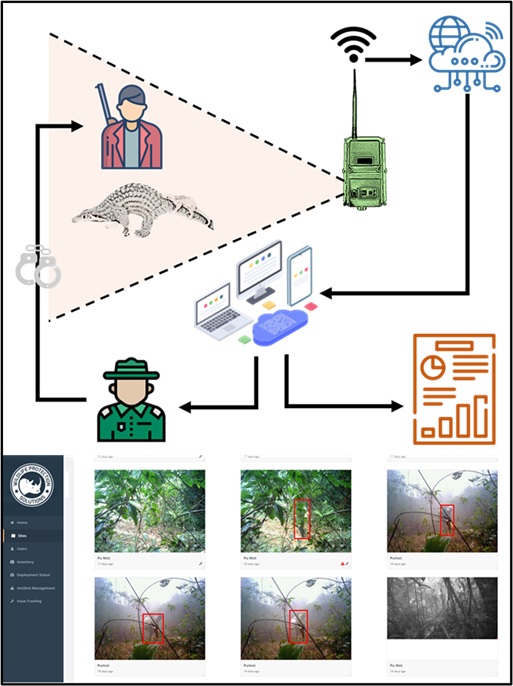

Our anti-poaching teams have improved the workflow of detecting and pre-emptively stopping offenders who illegally enter the protected forest areas by deploying PoacherCams -- automated detection systems that operate via camera traps and artificial intelligence classification of humans, animals, and vehicles (Figure 3). PoacherCams are strategically placed at entry points into protected forests adjacent to local villages and access trails. When the cameras detect a human entering the park at PoacherCam installation sites, the site manager will receive a notification on their Smartphone of the threat and location. The manager will then deploy a mobile unit (forest rangers) to survey the area or document the entry and exit activity of the offender over time and make an arrest. Our system also has a dashboard for record-keeping purposes and note taking which forestry law-enforcement can refer to later when issuing penalties and following up with their issuance with commune-level law enforcement. Through extensive patrolling efforts, we have identified numerous central access points from local villages into the protected forests and set PoacherCams to monitor them and take action where needed.
- External funding from donors willing to improve site protection efforts in Vietnam protected and conserved areas via new technologies. It is difficult to get government buy-in for new equipment and technology with limited resources until proof of success is achieved.
- Support by Panthera – both in providing us with cameras and technical with assistance setting them up on their server.
- Support by Wildlife Protection Solutions with re-routing camera messages and images to their dashboard and sent to rangers as WhatsApp alerts
- Cellular network connectivity
- PoacherCams must be well hidden, or set high up in trees, or they will be damaged or stolen
- Cellular network connection is required for the system to send alerts to ranger’s phones, and the weaker the cellular connection, the longer the message will take to be received.
- Sometimes, it is best to observe offenders entering and exiting the forest and record common times of entry/exit to then deploy a ranger to wait for them at the location, rather than deploy rangers immediately when alerts are received.
- Some smart phones cannot communicate with the Camera Trap Wireless Client app required to set up the camera. The app should be tested before leaving to the field
- the nPerf app may help to actively map cellular network connection strength in the field, and provide information on locations to optimize PoacherCam placement.
- Local people are quickly habituated to ranger patrol patterns and have their own communication networks. When local people from the villages see a ranger going toward a trail where the village hunter entered the forest, they will call the hunter and tell him to take another trail so they will not be caught.